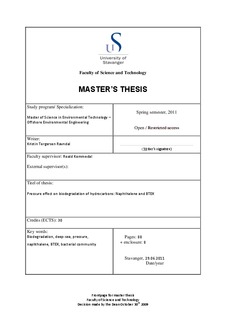| dc.contributor.author | Ravndal, Kristin Torgersen | |
| dc.date.accessioned | 2011-10-05T12:16:41Z | |
| dc.date.available | 2011-10-05T12:16:41Z | |
| dc.date.issued | 2011 | |
| dc.identifier.uri | http://hdl.handle.net/11250/182462 | |
| dc.description | Master's thesis in Environmental technology | en_US |
| dc.description.abstract | Oil and gas are the most important energy resources in the global economy today. Even though there is a growing concern for global heating, no real alternatives have been found. Current political disturbances in the Arab Countries give an increased interest in oil and gas coming from the Western producers. However in these areas the volumes and current reserves are in decline and new areas must be opened for explorations. This will in turn increase exploration and production in deep-sea environments.
These deep-sea environments are vulnerable due to harsh weather conditions and vast fish resources. Hence, it is paramount that production of oil and gas is done in a way that not damage this environment. Last year the oil spill by Deepwater Horizon was a warning of the possibility of damaging oil spills that the industry must prepare for, and even more important, the industry must understand the possible environmental effects of future incidents.
This thesis sheds new light on biodegradation in the deep-sea environment. This process is one of the important parts of natural remediation of environments polluted by hydrocarbons. It is first and foremost a part of nature’s own defence mechanism to cope with vast amounts of organic pollutants released to a vulnerable part of the ocean.
Experiments were performed to assess the effect of pressure on biodegradation of naphthalene and BTEX in seawater. Substrate removal and growth of bacterial cells were analysed. Removal of naphthalene was detected for samples at atmospheric pressure, but not for pressurised samples after 34 days. BTEX degradation was not detected in samples at 1 bar after 28 days, but seen after 35 days. At 80 bars degradation started between day 42 and 52. No degradation was detected after 56 days for 170 bar and 60 days for 340 bar. This indicates that increased pressure slows down the degradation process by prolonging the lag phase, hence prolonging the time needed by natural processes to remove a potential oil spill in the deep-sea.
Weathering processes for oil released to surface waters include evaporation to the atmosphere and degradation by UV radiation from sun light, neither of which is possible weathering processes in the deep-sea. Biodegradation is thus even more important as a natural process for removal of oil in the deep parts of the ocean. A prolonged lag phase, and hence a higher concentration of hydrocarbons in the ocean for a longer period could thus have large consequences for the ecosystem in the deep-sea. With the possibility of oil spreading to a large geographical area by ocean currents, and uptake and bioaccumulation of xenobiotics in food chains, a vast oil spill could have catastrophical effects on the aquatic environment.
Analysis of bacterial diversity shows that diversity decreases when the bacterial community is exposed to BTEX. The species found in samples incubated at 340 bar are also very different from samples from lower pressures, indicating that pressure affect which species that grow. Fewer species from seawater collected at 80 meters depth will tolerate being compressed to a pressure of 340 bar, than to 80 or 170 bar.
There are weaknesses in the methods used in this experiment. The lack of continuous monitoring renders it impossible to detect the exact moment the exponential phase starts. It also makes sampling at the right moments in the growth difficult. The seawater used in the experiment was collected from 80 meters depth, hence the bacteria used at elevated pressures are not initially piezophilic. Different behaviour can thus not be excluded for an inoculum collected from the deep-sea.
More experiments should be done to check if the data found indicating this pressure effect is reproducible. Further work should also focus on extending the numbers of substrates tested, and to improve the experimental method utilised in this work. Seawater collected from the arctic could be used to get closer to the actual ecology in the deep-sea, because of similarities between psychrophilic and piezophilic bacteria. The number of pressures analysed should also be expanded, and research should be done to find out at what depth pressure starts to affect biodegradation. | en_US |
| dc.language.iso | eng | en_US |
| dc.publisher | University of Stavanger, Norway | en_US |
| dc.relation.ispartofseries | Masteroppgave/UIS-TN-IMN/2011; | |
| dc.subject | teknisk miljøvern | en_US |
| dc.subject | offshore teknologi | en_US |
| dc.subject | biodegradation | en_US |
| dc.subject | deep-sea | en_US |
| dc.subject | pressure | en_US |
| dc.subject | naphthalene | en_US |
| dc.subject | BTEX | en_US |
| dc.subject | bacterial community | en_US |
| dc.title | Pressure effect on biodegradation of hydrocarbons: Naphthalene and BTEX | en_US |
| dc.type | Master thesis | en_US |
| dc.subject.nsi | VDP::Technology: 500::Environmental engineering: 610 | en_US |
| dc.subject.nsi | VDP::Technology: 500::Marine technology: 580::Offshore technology: 581 | en_US |
